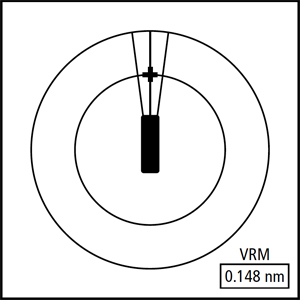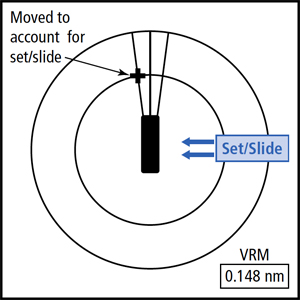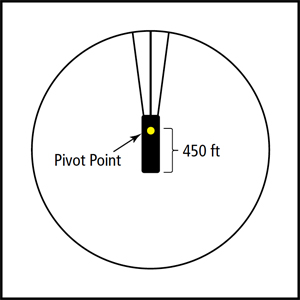I have heard it said many times over the years that there is an art and science to piloting. For the record, I believe this is true. To maneuver through narrow canals, heavy current, heavy wind and still put the vessel or tow safely on dock despite all this is truly an art form in and of itself. I compare it to watching my wife, who is an artist, paint a portrait. Sometimes I’m in awe of how she does what she does. The same can be said of piloting — it is definitely an art form.
There is, however, a serious problem with this approach to piloting, which is that most of us are not very good artists. Think of it this way: Rembrandt was a very famous Dutch artist. Even if you are not familiar with art, you’ve probably heard of him. The reason he was so talented was because he could envision an entire painting before he ever painted it. He knew what it would look like and what colors would go where by staring at a blank canvas.
Although we can appreciate Rembrandt for his skill and vision, and we can marvel at the amazing paintings he created, I doubt many of us could reproduce his work.
That brings me back to my point. There are among us those who can do the job at a very high level simply because they were born with artistry, the natural skill. They can look out the pilothouse window and see the entire maneuver to be performed before they even start. They know every engine movement, every rudder command, when to execute each, and how much of each will be required and never get it wrong. Piloting looks effortless behind their skilled hands; they are Rembrandt on the water. But again, if we take a hard look at our own skills, most of us are not Rembrandt. Most of us are not as naturally skilled as we wished we were. Though we try, we cannot do what the “artists” of piloting can do. And it’s unbelievably frustrating to watch artists at work and not be able to reproduce what they do with such grace and ease.
Having trained hundreds of steersmen, I can tell you with certainty that most of us are not artists — myself included. Our natural ability will never excel to the level we wish it would. So, after a number of years, our piloting skills plateau.
Have you ever felt that way? That you should be better at the job than you are? I know I did, and with my background I should have excelled easily. The problem is, I’m not an artist.
I attended one of the maritime schools. I graduated near the top of my class, received various awards for navigation, aced my license exams and came to work in the towboat industry in Houston.
Once I arrived, I began working as a steersman and in six months was promoted to the position of pilot. Over the course of two years, I was promoted to relief captain and began training steersmen. In my mind, I was extremely gifted; piloting was easy for me, and I believed I was better at it than most. I believed I was an artist.
I believed this for seven years, until one day I was pushing a tow inbound on the Houston Ship Channel and I realized something: I was getting set down onto the buoy line. Not that big of a deal, but I wondered, “How did I not see this coming?” As I steered back up to account for the set, I looked out the front window and asked myself, “Am I steering up enough? Do I need to steer more, or less? Am I going to clear this buoy? How close is it going to be?”
Have you ever asked yourself those kinds of questions? I realized in that moment that I really didn’t have the answers. I knew I needed to account for the set, but I didn’t know exactly how much I needed to steer. And when I steered, I didn’t have a guarantee what I was doing was sufficient to get the job done.
After putting the tow on dock, I thought more about my career up to that point. Though I had looked successful, and had done the job well enough, did I really know what I thought I knew? Did I know for certain that my choices were right every time?
After thinking long and hard, the answer seemed plain: I didn’t really know, I was always just guessing. Educated guessing perhaps, based on experience, but it was guessing nonetheless.
Here’s what I mean: I piloted vessels, as I’m sure many of you do, primarily by looking out of the front window to make my judgments — judgments as to when to turn, how much to turn, if I need to turn more or less, when to slow down, when to come ahead, how to account for slide, how to deal with wind/current, etc. The list would go on and on. I would glance at my radar and other instruments, but the window was my primary source of information. It was by looking out of the window that I made the majority of my decisions, based on how I felt about what I was seeing, which is probably what most of us do, if we’re honest. But, when we make judgments and decisions based on how we feel about what we see, you and I are guessing. Experience will allow us to guess with more accuracy, but in the end it’s all just guessing. And when you’re always guessing, you’ll eventually guess wrong.
 |
|
Diagram B. Set a VRM for double the length of the pivot point. If the pivot point is 450 feet from the radar scanner, set the VRM for 900 feet, or 0.148 nm. |
This is the crossroads at which I found myself: Keep guessing and stay at the same skill level forever, or find a better way.
I came to the harsh realization that I was no artist at piloting, though I previously believed I was. That was a hard pill to swallow. I realized I needed to know every decision I was making was the right one, not hope it was.
This is where we get into the science of piloting. Hopefully by now I’ve shown you that most of us are not Rembrandt. We are not artists. So if we are not artists, we need to become students of the science of piloting because most of us have peaked as far as our artistry is concerned.
Which would you prefer: to know with certainty the decisions you make are correct, or would you rather drive based on how you feel about what you see?
While how we feel about a situation should have some bearing on what we do, feelings are subject to interpretation. The only way to know what you are doing is correct is to have a system of measurement. Remember, knowledge is power.
And now we’ll get to the most controversial part of this argument: Unless you’re an artist — and most of us are not — you cannot know that what you’re doing is correct by staring out of the window, or what we’ll call “driving by eye.”
Now before you condemn me for heresy, let me explain why. Your eyes, with all their positives, are very, very bad at one thing: judging distance.
I’ll give you an example. As you’re reading this article, look around the room. Can you tell me exactly how long and how wide that room is? You can guess, but you don’t really know, do you? If there is someone else in the room with you, ask them how long and wide they believe the room is, and I’ll bet they have a different opinion than you do. The only way to know is to pull out the tape measure.
If your eyes can’t measure the length and width of the room you’re sitting in, how can we expect to judge distances that are 300, 600, 1,000 feet or more away? Though we think we can do this, our example proves we cannot — at least, not accurately. And if you cannot accurately judge distances, how can you make sound piloting decisions when the distances on which you are basing those decisions are not correct?
So, the question we are left with is this: Is there a better way to judge distances and thus make better piloting decisions? Thankfully, the answer is yes.
Let me predicate this by saying the technique I’m about to explain is built upon the “Running CPA” radar method for collision avoidance that Capt. John Moyle developed and published in Professional Mariner back in June/July 2006. Many of us use the Running CPA method on the inland waters already, but if it is new to you, please refer back to that article for reference.
Let me also state this technique is not new. It was developed back in the 1980s as a way to deal with large-tow navigation issues. However, it isn’t for large tows only. The type, size and location of the vessel do not matter. What does matter is the pilot’s ability to correctly identify the vessel’s pivot point in the prevailing circumstances and conditions.
Most of us understand the vessel maneuvers around its pivot point. When we’re running at cruising speed, the pivot point’s location is usually one-fourth to one-third of the distance back from the bow. The pivot point’s position on your vessel will move forward or back depending on speed, current and various other factors, but one-fourth to one-third of the distance back from the bow is a solid place to start.
For example, if we have a tow of 625 feet in length — 600 feet of tow plus 25 feet from the bow of the boat to the radar scanner — the pivot point’s location should be roughly 450 feet from your radar scanner. That is, one-fourth to one-third distance back from the bow (see Diagram A).
Because we know the vessel rotates around that position, we can use a technique called “gunsight steering” as a predictor of where the pivot point will be in the future. The way we do this is by doubling the length of the pivot point.
 |
|
Diagram C. If the set/slide of your vessel is to port, as shown above, move the cursor to the intersection of the port EBL and VRM. If the set/slide is to starboard, move the cursor to the intersection of the starboard EBL and VRM. |
For our example, that would be 450 feet times two, or 900 feet. Because our radar is very accurate at measuring and our eyes are not, we’ll use the variable range marker (VRM) to set a ring for that distance. Because most radar VRMs measure in nautical miles, we’ll have to convert our 900 feet to nautical miles. We do this by dividing 900 feet by 6,080 feet, and that equals 0.148 nm. Set a VRM for this distance. Put the crosshair of the radar at the intersection of the header line and the VRM. We’ll call that your “gunsight” (see Diagram B).
You now have a predictor of where your pivot point — and subsequently your vessel — will be in the future. Your vessel will follow the gunsight like a dog following a bone. Wherever the gunsight goes, the vessel will follow. You are essentially pretending that the gunsight is your vessel, so you are steering the gunsight, not the vessel. You are steering where you are going to be, not where you currently are, knowing the vessel will follow the gunsight.
Now we can answer some critical questions: When do you start steering for the bend? Answer: When the gunsight gets to the point where you would normally start steering by eye. How much to steer? Answer: Enough to keep the gunsight on my side of the channel.
The technique above works as long as the conditions are not creating a set or your steering isn’t creating any slide. However, we know set and slide happen all the time.
To account for set/slide, you’ll need to adjust the position of your gunsight. Let’s say we have wind hitting us on our starboard side, setting us to port. If we leave the gunsight in on the header line, our vessel will not follow it since we will be getting set to the port. To account for this, we will move the gunsight to the intersection of the port electronic bearing line (EBL) — from the Running CPA method — and the VRM. Now the gunsight will show us farther out of our lane than we would want to be, and hence we would steer to starboard to bring the gunsight back into our lane (see Diagram C).
The same is true for slide created from steering. If we are steering a bend to port, our slide will naturally go to the starboard. To account for this, move your gunsight to the intersection of the starboard EBL and the VRM. It will show you deeper in the bend than you would probably like to be — the predicted slide — and so you steer to port enough to keep your gunsight in your lane.
Just as “driving by eye” isn’t piloting, neither is “driving solely by radar.” We need to confirm that our placement of the gunsight is representing what is happening in real life. We need to be able to answer the question, “Did I set the gunsight in the correct position?”
The way you confirm is by looking out the window — and at the electronic chart, if fitted. Look at the position of your vessel. Is it following where the gunsight is telling you it will be? If not, adjust the gunsight left or right until it is predicting your position correctly.
For example, perhaps you set the gunsight at the intersection of the port EBL and VRM to account for the wind/current setting you to port. As you look out of the window you realize you are not getting set as much as you thought you were, so you may move your gunsight back toward the header line slightly for the smaller set. The same works for slide in a bend.
Believe me when I tell you that I have played both sides of this piloting coin. For years I was driving by eye, staring out of the pilothouse window, occasionally glancing at my radar and electronic chart, believing I knew what I was doing and my decisions were correct. But after an honest look at my own ability, I realized I was no artist. The problem was that I still wanted to get better. I didn’t want to stay at the level where I was, and I believe that is true for most of us. We want to be better than we currently are, but we just don’t know how.
So, to overcome my inadequacies in the art of piloting, I had to learn the science of piloting, which is simply math being applied on the water. That’s all gunsight steering is, math. But math helps move us from guessing to knowing. It is very hard to argue with math.
Capt. Nicholas Henrich, who lives in Kingwood, Texas, has been a towboat pilot and trainer in Houston for nine years.

